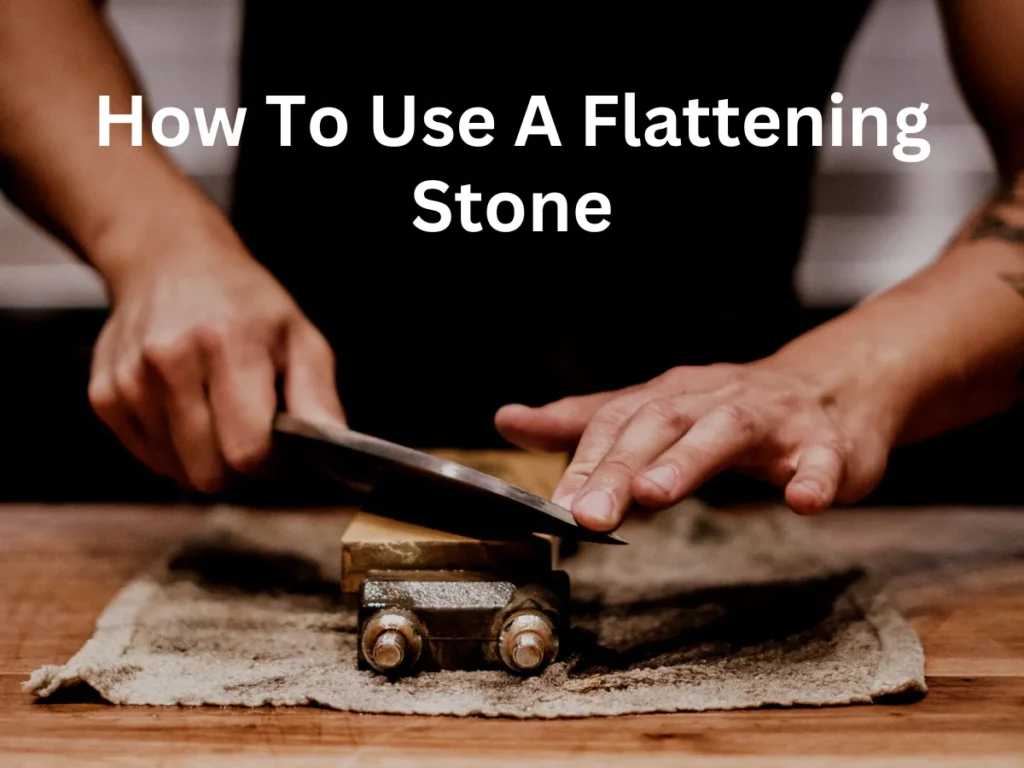So your whetstone isn’t sharpening your knives anymore, it’s a very common problem, and the fix to that is simply reviving your whetstone by using a flattening stone. But what is a flattening stone? it’s basically something that you use to “flatten” your whetstone after you’ve used it too much.
It works by removing a layer from the whetstone which in turn exposes the fresh layer underneath. A flattening stone is also known as a lapping plate.
Here Is Why You Need A Flattening Stone
A flattening stone is an essential thing to have in your knife sharpening arsenal because here’s what happens when you sharpen your knives:
You essentially stroke the knife forwards, and then backwards, this continuous motion often creates bumps and curves on the stone that are usually a bit hard to notice unless you look very carefully, now these bumps on your whetstone can cause harm to you as well as the knives that you sharpen.
The bumps can cause the knives to develop an uneven edge, destroying their capability to cut properly, and it can also cause incorrect strokes which can result in cutting your hand.
So how do you prevent this? that’s right, by getting a flattening stone.
Types Of Flattening Stones
There are usually two types of flattening stones:
1. Silicon Carbide Stone (Cheaper Option):
A silicon carbine stone is usually the most common type of flattening stone as it can be obtained at a price between $15-60. In addition to that, silicon carbide stones are very coarse, usually between 400 to 1000grit, because they need to be able to successfully take off a layer from the whetstone.
2. Diamond Plate (Expensive Option):
A diamond plate is also used in sharpening whetstones, however these are much more expensive than silicon carbide stones, they can cost anywhere between $100-$500, but they are very long lasting and are kind of a one time investment, apart from that they are also much better at restoring whetstones.
So which one is the better option? if you’re a beginner then we would say that stick to a silicon carbide stone because it’s cheaper, but if you’re a firm or an established company then definitely use a diamond plate because it gives better results.
Here Is How A Flattening Stone Works
Flattening stones are usually coarse, that’s because they need to be able to remove a layer from your whetstone, they commonly have grooves which help in removing the whetstone particles.
You put the groovy side of the flattening stone on top of your whetstone, use mineral oil or running water and then scrub , which then peels off a layer from your whetstone.
How To Use A Flattening Stone
Step 1: Preparing Your Stones
The first step is to prepare both of your flattening stone and your whetstone, make sure that both of the stones are clean , you can use any type of cloth to clean them.
After that soak both of the stones for about 15-20 minutes.
Step 2: Draw Lines On Your Whetstone With A Pencil
Lines are used to ensure that the top layer on your whetstone has been peeled off, Draw horizontal and vertical lines on your whetstone using a pencil.
Step 3: Start Rubbing The Stones
Use the coarse side of the flattening stone and lay it so that it comes on top, after that start rubbing your whetstone on the flattening stone by using a circular motion, keep repeating the motion till the pencil marks dissappear.
Once you’re done with that simply use the fine side of the flattening stone to further polish the whetstone.
Do You Need To Soak A Flattening Stone?
Although soaking a flattening stone isn’t necessary but doing it may make the process more cleaner and smooth.
How To Flatten A Stone With Sandpaper
Don’t have a flattening stone? Don’t worry! using a sandpaper is a very cost effective method to flatten your whetstone, here’s how you can do it:
Step 1: Get A Coarse Grit Sandpaper
although any kind of sandpaper will do the trick, coarse grit ones are usually better at imitating results from a flattening stone.
Lay down the sandpaper on a table.
Step 2: Draw Lines With A Pencil On Your Whetstone
Just like with a flattening stone, you need to be able to see how far the stone has flattened and you can do that by drawing lines either in a horizontal or checked pattern.
Step 3: Spray water on your sandpaper and start scrubbing
Now with a sandpaper, it’s actually a bit difficult to do the circular motion, so you’re going to rub the whetstone back and forth on the sandpaper, rotate it and then repeat the motion until the lines on the whetstone disappear.
Best Method To Flatten Whetstone
The best method is to use a diamond plated flattening stone, but it’s definitely not necessary because you can use sandpaper or a silicon carbide flattening stone without compromising results.
FAQs
How often should you flatten your whetstone?
There is no set time frame, but whenever you start to notice that your knives aren’t being sharpened properly, or if you start to notice deformity then that is the best time to flatten your whetstone.
What grit is best for flattening stone?
Coarse grits are usually better for flattening stones, the most common one is the 180 grit stone.
Conclusion
So this is how you use flattening stones, keep in mind that you should always wear gloves and use proper equipment whenever sharpening your knives or reviving your whetstones.

